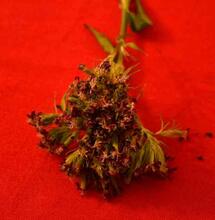What Are the Medical Benefits of Cannabis for HIV/AIDS Patients?

The AIDS epidemic outbreak of the 1980s was as destructive as it can be, taxing not only a great many young lives but also causing a social stigma for everyone who has contracted an infection. A lot of people suffering from HIV/AIDS have found relief in cannabis — the one remedy that could help combat nausea, loss of appetite and weight loss among other disease manifestations.
Perhaps medical marijuana did not help eradicate the plague of the 20th-century, but it sure did help its victims find some comfort and relief. As this month we commemorate 40 years since the first case of AIDS was diagnosed in the U.S., below you can find out how marijuana helps in the treatment of AIDS/HIV.
As we are celebrating June — the month of Pride, we are also remembering all gay people who lost their lives to AIDS-related complications. As the world is navigating through the havoc of the global covid-19 pandemic, it is also important to remember that the LGBTQ community has in the past faced its own health crisis that quaked the foundation of an entire generation of gay folks.
The AIDS epidemic outbreak of the 1980s was as destructive as it can be, taxing not only a great many young lives but also causing a social stigma for everyone who has contracted an infection. A lot of people suffering from HIV/AIDS have found relief in cannabis — the one remedy that could help combat nausea, loss of appetite and weight loss among other disease manifestations.
HIV was a new and unknown virus to the medical world back in the 1980s. Victims at high risk of contracting a serious illness as a result of infection suffered from illnesses we don't see frequently these days, including Kaposi's sarcoma (a rare form of skin cancer), AIDS dementia, and HIV wasting syndrome. The last one of these, the infamous HIV wasting syndrome was also what prompted more and more doctors to try out medical marijuana as a method of treatment.
Cannabis flower, it turned out, helped victims stimulate their appetite and cope with astonishing weight loss typical for this syndrome. Since patients and medical personnel both began to see the benefits of pot for AIDS treatment, research on medical marijuana advanced, and new drugs were also developed.
Marinol
We can’t deny that the ’80s were wild on so many levels, but the legalization of medical marijuana was still taboo. Since the plant was forbidden in medical settings, doctors began prescribing the Schedule III drug Marinol (dronabinol), which contains a synthetic form of tetrahydrocannabinol (THC), the active ingredient of cannabis.
The studies supporting the use of Marinol have since been relatively well established. Increasing the appetite, Marinol in fact can increase the lean muscle mass in people with wasting syndrome related to HIV/AIDS according to research published in February 2016 in NCBI. Marinol has the immediate effect of pain and stress relief and it exceeds smoking marijuana in terms of gaining weight.
HIV-Associated Neuropathy
In the early days of the outbreak, AIDS patients were considered as leprose, largely owning to their skin condition. The choice of wardrobe and dressing was a way to mask the eye-popping external appearance. But the opaque disease literally affects every body part. For instance, feeling numb, “pins and needles” and similar terms are used to describe this condition that occurs when the exterior sheath covering nerve cells is stripped away. It's a common HIV/AIDS side effect and marijuana has proven to alleviate this painful nerve condition called peripheral neuropathy.
Wasting Syndrome
The deteriorating appearance of people with HIV is directly linked with the AIDS wasting syndrome and probably the most representative side effect of this condition. The Centers for Disease Control and Prevention defines AIDS wasting syndrome as the involuntary loss of more than 10 percent of body weight, accompanied by diarrhea or fever that lasts more than 30 days and is not attributable to another illness.
Wasting is a combination of two different physiological processes, cachexia (loss of the lean tissue mass) and starvation (food deprivation). Even in the early stages of the disease, people can begin to lose weight as a result of the viral infection, and after developing full-blown AIDS, other infections like ulcers of the mouth, throat, or esophagus make eating even more difficult. Add to this, more infections, depression, fatigue, and poverty, that may further exacerbate malnutrition in AIDS patients.
Until today, THC is the only cannabinoid that has been proven for medical use for its ability to stimulate appetite and thereby counteract AIDS wasting. The only problem occurs by the difficulty of fine-tuning the dosage of THC in pill form and its slow reaction in the human body. This is the reason why some AIDS patients prefer smoking marijuana to swallowing THC-containing capsules.
In May 2000, Donald Abrams, a medical researcher at the University of California at San Francisco, completed the first controlled study of the short-term safety of smoked marijuana in HIV patients. The results showed that patients who smoked marijuana every day for three consecutive weeks did not show any increase in the HIV virus during the study period.
Nausea and Vomiting
Nausea, diarrhea, fatigue, vomiting, and loss of appetite can become a way of life for many AIDS patients even when combining medicine does not make these people terminally ill like in the old days. But only patients with a chronic disorder, which can be managed. This is the reason why many AIDS patients appear to be using marijuana to counteract the side effects of prescribed medicines as well as to treat disease symptoms.
The effectiveness of marijuana and cannabinoids in reducing nausea and vomiting brought on by AIDS medications remains to be determined in the clinic. Cannabis-based drugs for AIDS that address nausea are in fact the same drugs as used for chemotherapy-induced vomiting in cancer patients. Besides cannabinoids can target nausea and vomiting in AIDS patients, they could help also the group of cancer-suffering patients. It is important to note that each case is individual and for some patients, medications will be required for controlling nausea and vomiting that do not include cannabinoids.
Mental Health
The combination of negative physiological, psychological and social pressures is often the cause of depression and anxiety in AIDS patients. In 2007, in a double-blind study, researchers found that cannabis improved respondents’ mood and caused a ‘good drug effect’ that increased pleasant feelings and bigger self-esteem. And whether you might be wondering if there's any difference between the medical use of marijuana in treating anxiety or depressed mood and the recreational pursuit of high, it's worth mentioning that many patients have discovered the drug's medical benefits through recreational experience.
Other people who have started using marijuana just to improve their appetite, have also claimed that their mood has improved. However, there are patients who have reported negative side-effects of using marijuana, especially patients who have never smoked marijuana before. Rather than calming them, marijuana or THC seemed to make this group of people even more anxious, with some of them reporting feeling dizzy, disconnected from reality, and even psychotic. According to medical marijuana advocates, such patients rarely experience adverse psychological reactions if they are given adequate guidance about what to expect before using marijuana for the first time.
Pain Relief
Patients with HIV/AIDS can suffer from severe pain arising from complex sources, including joint, nerve, and muscle pain. The good news about relieving the pain comes from a Canadian study that evaluated the safety of cannabis use by patients with chronic pain over a year-long period. Namely, the participants were provided with a standardized cannabis product (12.5% THC) in the form of flowers, concentrates, or edibles.
The results perhaps weren't revolutionary but at least, patients did report pain reduction and increased quality of life. Numerous studies have confirmed a link between inhaling cannabis and pain relief. A 2013 study analyzing the effects among 23 people found that inhaling 25 mg of 9.4% THC three times per day for five days decreased pain and improved sleep quality.
Finding a cannabis strain that acts as a superior pain reliever has never been easier today. In your local dispensary, look for Dakini Kush, LA Kush Cake, Chem Cookies, CBD OG, Stevie Wonder, Luca Brasi x Sour Diesel, Alien Dutchess, or Pure Love. Most of these strains are hybrids, but every once in a while there's a good sativa or indica that could help with pain relief. And that's for pain regardless of what condition is the source of pain.
Pride and Prejudices
This was not put on a medical trial or any study. AIDS victims were demonized for a long time for their lifestyle, especially within the LGBTQ community. So, what happens when someone gets judgemental, it pays to remind them that puritans may have been popular in the 17th-century. And that the best-proven medicine against prejudices is a beautiful big fat joint shared with friends that will put a smile on everyone's face and will give you an opportunity to talk, listen and understand other people's struggles. Until we wait for our cannabis parade, we can all join with our joints on this month's Pride parades. Happy Pride to everyone, love is love and this refers to the love for marijuana too!



